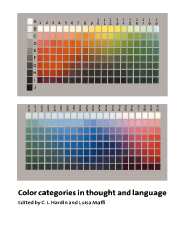2 - Color naming across languages
Published online by Cambridge University Press: 20 August 2009
Summary
Introduction: prior cross-linguistic research on color naming
This chapter summarizes some of the research on cross-linguistic color categorization and naming that has addressed issues raised in Basic Color Terms: Their Universality and Evolution (Berlin and Kay 1969, hereafter B&K). It then advances some speculations regarding future developments – especially regarding the analysis, now in progress, of the data of the World Color Survey (hereafter WCS). In the latter respect the chapter serves as something of a progress report on the current state of analysis of the WCS data, as well as a promissory note on the full analysis to come.
B&K proposed two general hypotheses about basic color terms and the categories they name: (a) there is a restricted universal inventory of such categories; (b) a language adds basic color terms in a constrained order, interpreted as an evolutionary sequence. These two hypotheses have been substantially confirmed by subsequent research.
There have been changes in the more detailed formulation of the hypotheses, as well as additional empirical findings and theoretical interpretations since 1969. Rosch's experimental work on Dani color (Heider 1972a, 1972b), supplemented by personal communications from anthropologists and linguists, showed that two-term systems contain, not terms for dark and light shades regardless of hue – as B&K had inferred – but rather one term covering white, red, and yellow and one term covering black, green and blue, that is, a category of white plus “warm” colors versus one of black plus “cool” colors.
- Type
- Chapter
- Information
- Color Categories in Thought and Language , pp. 21 - 56Publisher: Cambridge University PressPrint publication year: 1997
- 76
- Cited by



